Agriculture has evolved, and farmers are seeking ways to boost their income. Pomegranate intercropping is gaining popularity as a technique that allows farmers to double their earnings by combining pomegranate cultivation with compatible intercrops. In the quest to enhance their income, farmers are embracing innovative agricultural practices, and one method gaining significant attention is pomegranate intercropping.
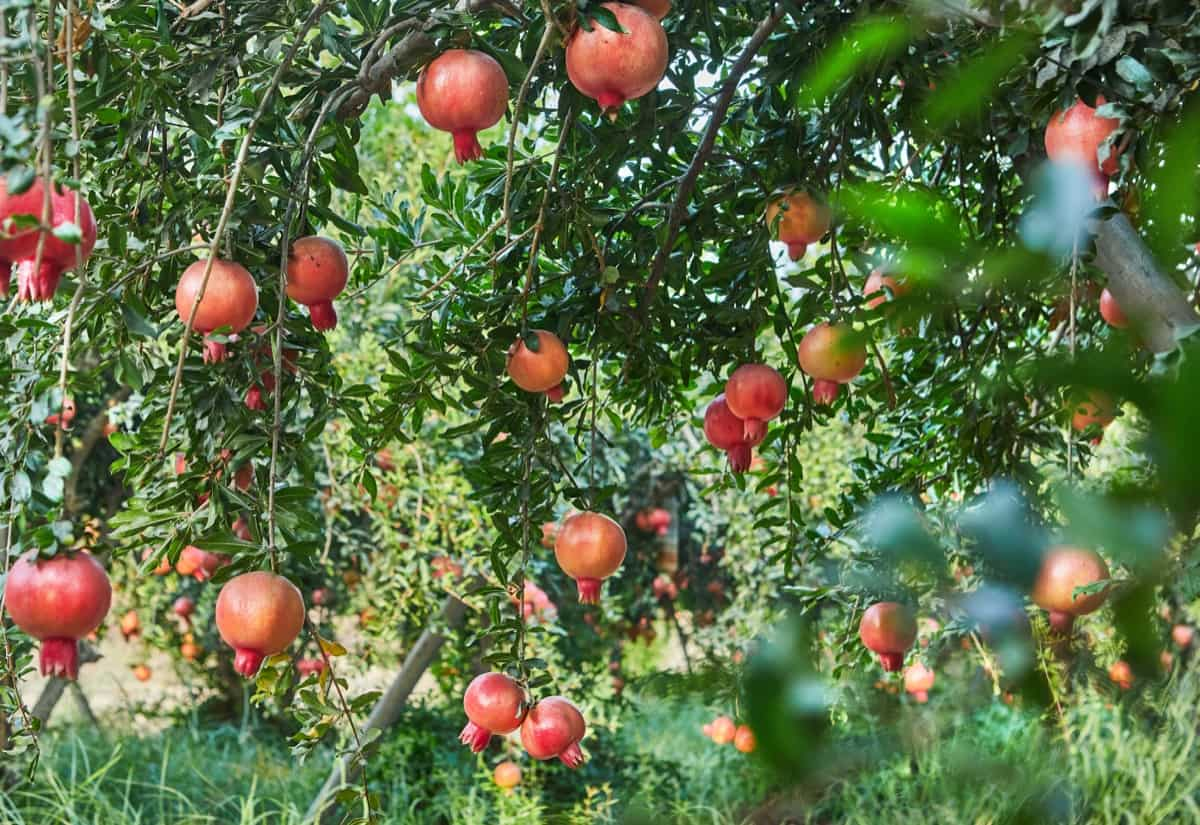
This technique allows farmers to double their earnings by combining pomegranate cultivation with compatible intercrops. In this blog post, we will explore the intricacies of pomegranate intercropping and provide practical insights for farmers to maximize their income effectively.
What is Pomegranate Intercropping?
Pomegranate intercropping refers to cultivating pomegranate trees alongside compatible crops in the same field. It involves strategically integrating different crops to maximize land utilization and overall productivity. Pomegranate intercropping is based on the principle of complementarity, where different crops’ growth characteristics and resource requirements are harmonized to achieve mutual benefits. The intercropped crops can include vegetables, legumes, or grains that thrive under similar growing conditions.
Intercropping in Pomegranate to Maximize Farmer’s Earning
Intercropping can be practiced for 2-3 years after planting pomegranate trees. Farmers can grow pulses, vegetables, or green manuring crops alongside the pomegranate trees during this time.
- To regulate flowering and fruiting patterns for commercial viability, a technique called “bahar treatment” is employed. This treatment involves withholding irrigation two months before the desired flowering period, followed by light earthing up in the basin. This helps the trees shed their leaves.
- After medium pruning, which takes place around 40-45 days after irrigation is stopped, recommended fertilizer doses are applied, and irrigation is resumed. This promotes abundant flowering and subsequent fruiting, with harvest occurring 4-5 months after flowering.
- In tropical regions, there are three distinct flowering seasons: January-February (ambia bahar), June-July (mrig bahar), and September-October (hasta bahar). The choice of flowering/fruiting season depends on factors such as availability of irrigation water, market demand, and pest/disease incidence in the specific locality.
- The ambia bahar crop, harvested from June to September, is desirable for export due to its attractive color and quality resulting from fruit development during dry months. The mrig bahar crop, harvested from December to February, benefits from the rainy season and requires less irrigation.
- Fruit color and sweetness may be affected. Hasta bahar crop, harvested in March to April, yields fruits with dark-colored arils and high value but can be challenging due to limited availability and poor flowering caused by coinciding with the rainy season.
In case you missed it: Fruit Borer in Pomegranate: Symptoms, Causes, Control, and Treatment
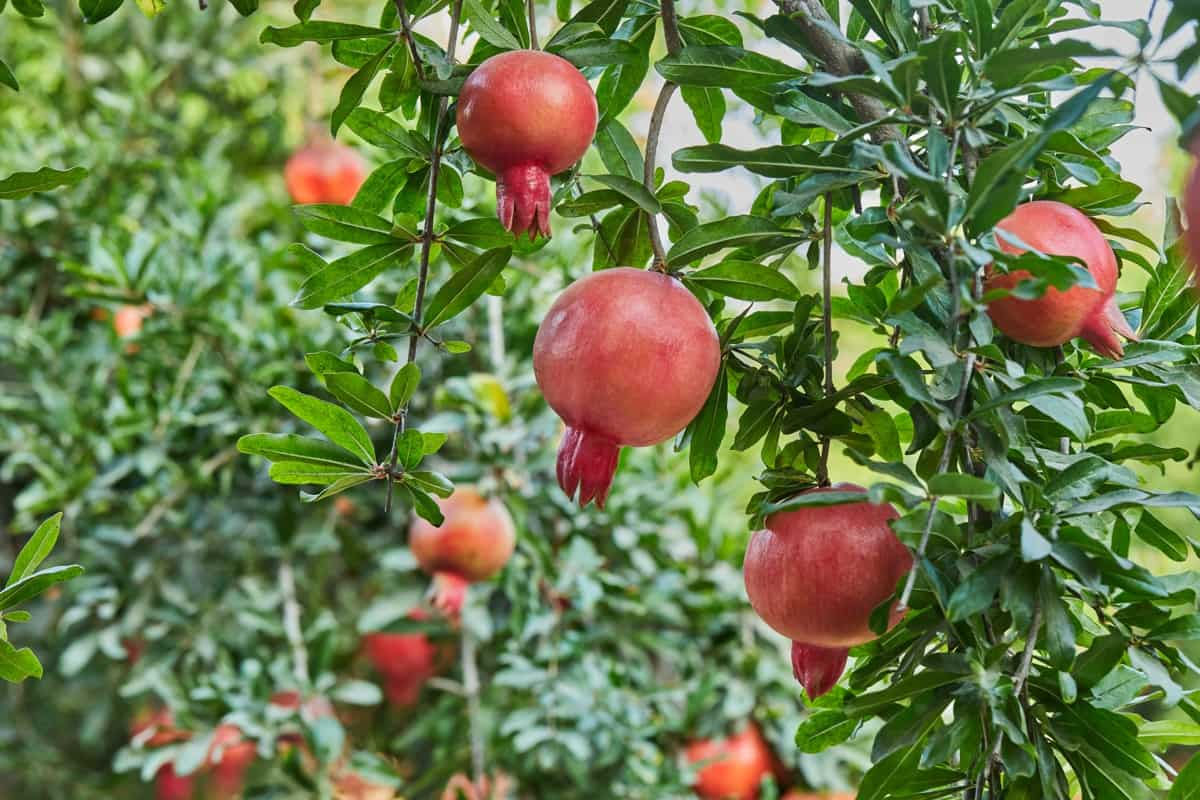
Pomegranate Production in India
Pomegranate cultivation has emerged as a highly profitable crop compared to traditional food and oilseed crops. To double farmers’ income the Indian government has focused on improving technology and policies and promoting high-value crops like fruits and vegetables.
- Achieving an annual growth rate of 10.4 percent is crucial for this endeavor. Over orchard maturity years, there has been a significant increase in the area and production of pomegranates, making India the world’s largest producer and exporter of fresh and processed pomegranates since 2013.
- The Pomegranate is an ancient fruit with historical and cultural significance, known for its nutritional and medicinal value. Its cultivation enhances farmers’ income and contributes to social security in India.
- Pomegranate’s nutritional composition varies depending on factors like cultivars, soil, climate, and region. The fruit is rich in minerals, antioxidants and vitamins.
- With its high antioxidant content, pomegranate juice can help remove free radicals, protect cells, and reduce inflammation. It contains more antioxidants than red wine and green tea.
- The Pomegranate has been cultivated since ancient times and symbolizes health, fertility, and rebirth in many cultures. Studies have also shown that pomegranate consumption can reduce stress-induced myocardial ischemia, lower blood pressure, and improve cardiovascular health.
Selecting Ideal Intercrops for Pomegranate
Intercropping is an effective agricultural practice involving growing two or more crops near the same field. When selecting ideal intercrops for pomegranate cultivation, several factors must be considered, such as crop compatibility, nutrient requirements, growth patterns, and management simplicity. Farmers can maximize land use, enhance soil fertility, control pests and diseases, and ultimately increase farm productivity by carefully choosing intercrops. Here are some recommendations for intercropping with Pomegranate, along with concise and accurate data summaries:
Legumes: Leguminous crops like chickpeas and lentils can be excellent intercrops for Pomegranate. They have nitrogen-fixing abilities, enriching the soil with essential nutrients. Legumes exhibit complementary growth patterns with Pomegranate, resulting in efficient space utilization. Studies have shown that intercropping Pomegranate with legumes can enhance fruit yield by up to 20%
In case you missed it: How this Farmer Made 42 Lakhs from 5 Acres of Organic Pomegranate Farming: Fruit Cultivation Sucess Story in India
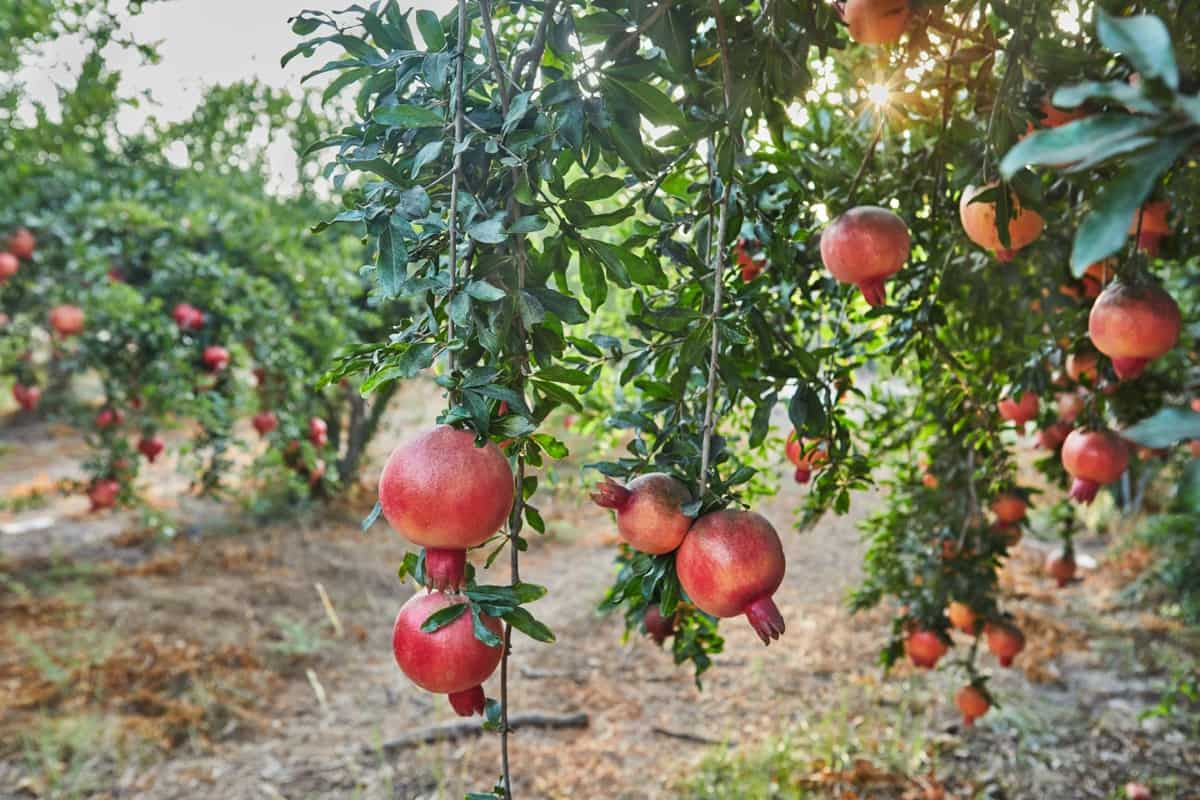
Herbs: Planting aromatic herbs such as mint or basil as intercrops for Pomegranate can provide multiple benefits. These herbs repel pests and attract beneficial insects, reducing the need for chemical pesticides. Moreover, their shallow root systems do not compete significantly with pomegranates for nutrients or water. Research indicates that intercropping Pomegranate with herbs can increase farm income by 10-15%.
Leafy greens: Intercropping Pomegranate with leafy greens like spinach or lettuce offers a short management cycle and easy cultivation. Leafy greens are rapidly growing and can be harvested early, allowing farmers to generate income before the pomegranate trees mature. Furthermore, these crops provide temporary shade, which reduces soil temperature and conserves moisture. According to a recent survey, intercropping pomegranates with leafy greens has shown a 30% reduction in water requirements.
Cereals: Growing cereals, such as wheat or millets, as intercrops for Pomegranate can be advantageous. Cereals act as living mulches, suppressing weed growth and conserving soil moisture. They also serve as windbreaks, protecting pomegranate trees from strong winds. Research data suggests that intercropping Pomegranate with cereals can reduce weed infestation by 40%.
Intercropping in Pomegranate Fruit Orchards
Intercropping is an agricultural practice that involves growing different crops simultaneously on the same land. It offers several advantages, such as increased crop productivity through efficient utilization of sunlight and optimal spatial distribution of plant architectures. In the context of pomegranate fruit orchards, intercropping refers to growing economic crops in the vacant spaces between the fruit trees during the initial years.
This practice allows farmers to utilize the available space efficiently and generate additional income from the same land. Intercrops serve as cover crops, benefiting from the cultivation, irrigation, and fertilization provided to them. Vegetables are particularly suitable as intercrops due to their short duration, shallow roots, bushy or climbing growth patterns, and low plant height. They have higher productivity and profitability compared to cereals or other crops. A cropping system combines crops grown on a specific land area over a defined period.
It aims to maximize productivity, optimize resource utilization, minimize environmental impact, and ensure long-term sustainability. Intercropping, as a part of cropping systems, involves growing different crops simultaneously. It can be classified into row intercropping, mixed intercropping, and stripe intercropping based on the arrangement of crops. The performance of intercrop components can be evaluated using the land equivalent ratio (LER), which measures the combined yield advantages of intercropping systems.
In case you missed it: High Yield Hybrid Pomegranate Varieties in India: State Wise
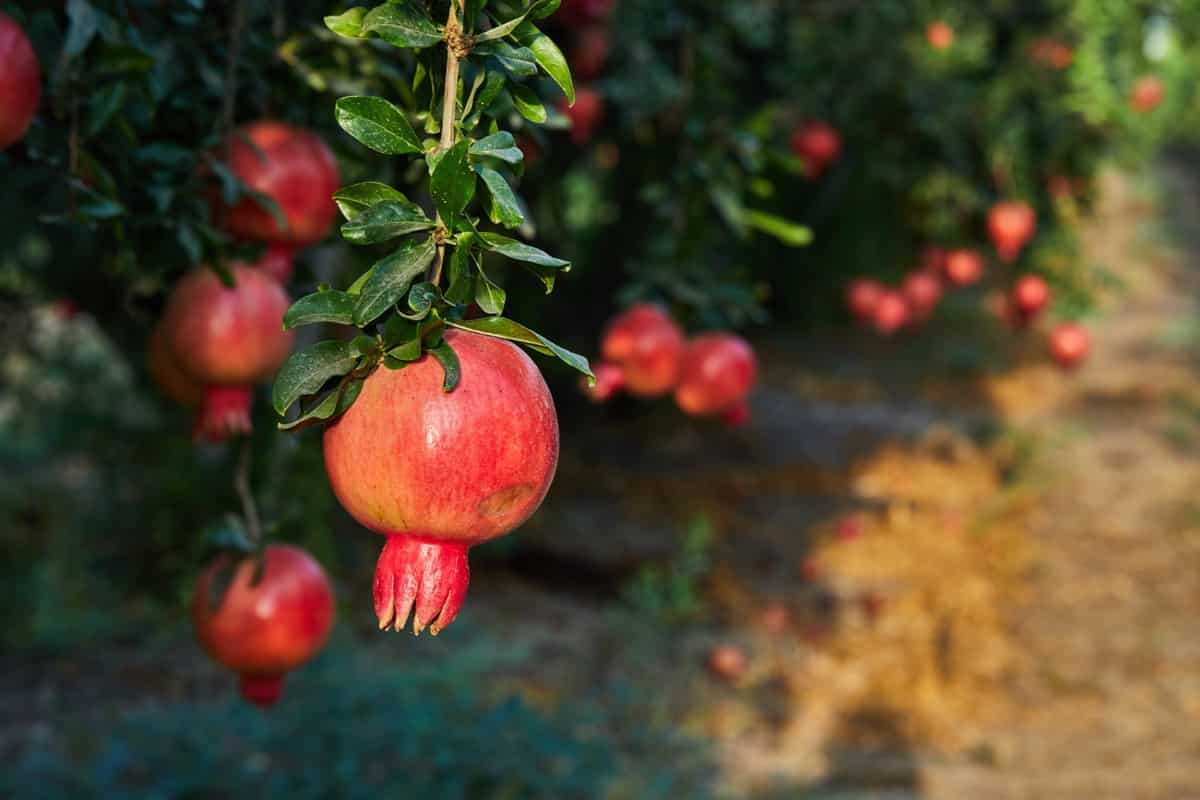
Merits of Intercropping in Pomegranate
- Risk reduction: Intercropping diversifies income sources, reducing the risk of complete crop failure.
- Efficient space utilization: Utilizing vacant spaces between pomegranate trees maximizes land productivity.
- Resource optimization: Intercrops utilize sunlight, water, and nutrients efficiently, enhancing overall productivity.
- Increased returns: Intercrops, particularly high-value vegetables, generate additional income from the same land.
- Weed and pest control: Crop diversity helps suppress weeds and reduce pest populations naturally.
Demerits of Intercropping in Pomegranate:
- Additional inputs: Intercropping requires extra labor, fertilizers, and management efforts.
- Machinery limitations: The presence of intercrops can hinder the use of machinery for certain operations.
- Allelopathic effects: Some crops may release biochemicals that negatively affect pomegranate growth.
- Competition for resources: Intercrops may compete with pomegranate trees for water, nutrients, and sunlight.
- Complexity: Intercropping requires careful planning and management to ensure compatibility and avoid negative interactions.
Vegetable-Based Intercropping System
Vegetable-based intercropping systems in one-and-a-half-year-old pomegranate orchards during the rabi and kharif seasons of 2015-16 and 2016-17. Assess the productivity and economic returns of different intercropping combinations compared to sole pomegranate plantations.
Five treatment combinations were tested: pomegranate + onion – Indian squash, Pomegranate + radish – cowpea, sole onion – Indian squash, sole radish – cowpea, and sole Pomegranate. The study examined various parameters to evaluate the effectiveness of intercropping systems. The results indicated that intercropping positively influenced the growth of pomegranate trees, including height, girth, and canopy spread when compared to sole plantations.
In case you missed it: Fertilizer Management in Pomegranate Trees: Organic, Homemade, Liquid, NPK, Schedule, and Application
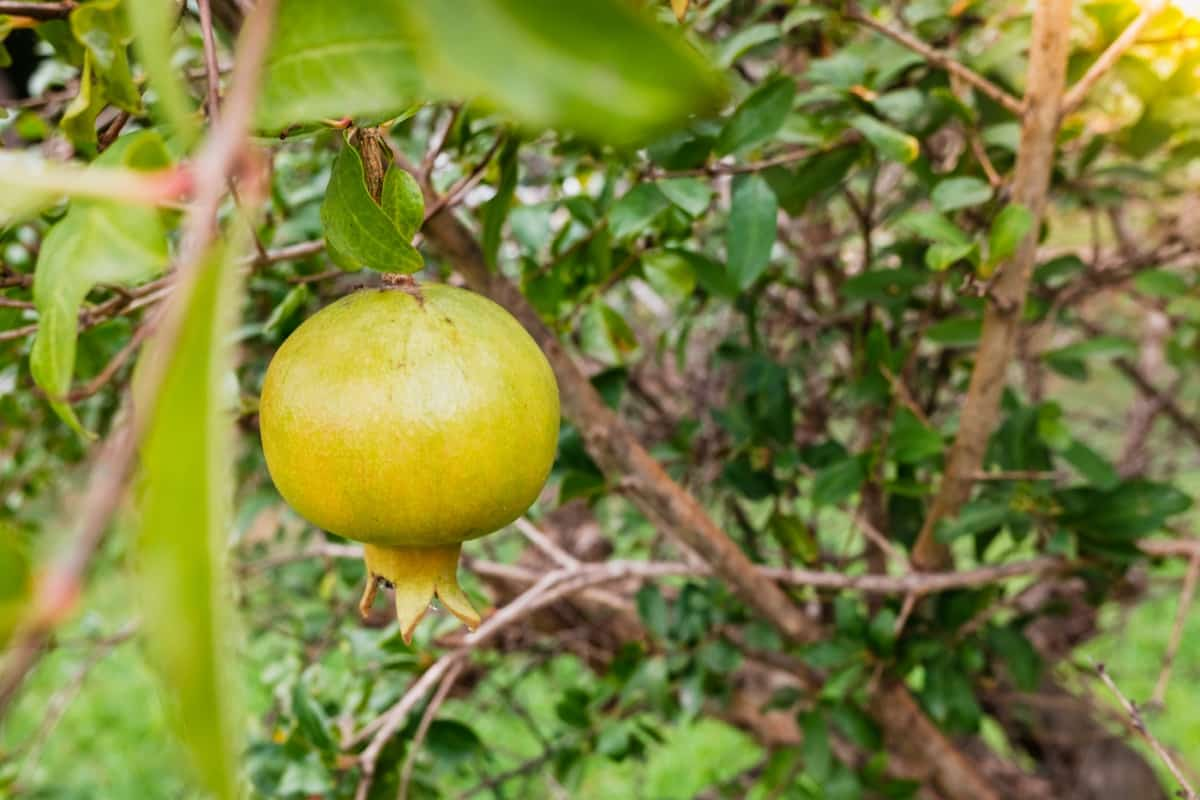
This demonstrates the potential for enhancing the overall productivity of pomegranate orchards through intercropping practices. When assessing the annual system productivity in terms of onion equivalent yield (OEY), it was found that the sole onion – Indian squash system exhibited the highest productivity. However, the intercropping system of Pomegranate + onion – Indian squash was comparable and yielded promising results.
Intercropping systems also showed positive impacts on water productivity. The intercropping combination of Pomegranate + radish – cowpea achieved water productivity of 2.87 kg/m^4 in terms of economic yield (WPEY), while Pomegranate + onion – Indian squash reached 6.71 kg/m^4 in WPEY. These figures indicate the potential to optimize water usage and improve overall resource efficiency through intercropping.
Economic returns were also considered in the study. The intercropping system of Pomegranate + radish-cowpea showed enhanced gross returns (WP”) of 130.5 Rs/ha^2. Similarly, the intercropping system of Pomegranate + onion – Indian squash demonstrated even higher gross returns, amounting to 378.6 Rs/ha^2. These findings suggest that intercropping can positively impact the financial viability of pomegranate orchards.
The additional income generated by intercropping systems compared to sole pomegranate plantations further emphasizes their potential. The intercropping combination of Pomegranate + onion – Indian squash provided an additional income of Rs. 2.36 lakhs/ha/year, while pomegranate + radish – cowpea generated 0.49 lakhs/ha/year. These figures highlight the economic benefits that farmers can attain by adopting vegetable-based intercropping systems in pomegranate orchards.
Crop Management Techniques for Successful Intercropping
Crop selection: Carefully choose compatible crop combinations based on their growth habits, nutrient requirements, and water needs. Consider crops with complementary characteristics to avoid competition for resources. For example, combining deep-rooted and shallow-rooted crops can optimize resource utilization.
Spacing and arrangement: Determine optimal spacing and arrangement patterns to maximize light interception, nutrient uptake, and water availability. Proper spacing allows for efficient resource distribution and minimizes shading effects between crops. Maintain an appropriate distance between rows and plants to avoid overcrowding.
Nutrient management: Implement a balanced fertilization plan tailored to the nutrient requirements of each crop in the intercropping system. Conduct soil tests to assess nutrient levels and adjust fertilizer application accordingly. To enhance soil fertility, incorporate organic matter and employ nutrient management practices, such as crop rotation and cover cropping.
Water management: Develop an irrigation schedule based on the water requirements of each crop. Consider variations in root depths and growth stages when determining irrigation intervals and quantities. Implement efficient irrigation methods, such as drip or precision irrigation, to minimize water wastage and ensure uniform water distribution.
Pest and disease control: Monitor crops regularly for pests and diseases. Implement integrated pest management strategies, including cultural practices, biological control, and judicious use of pesticides. Choose pest-resistant crop varieties and employ crop rotation techniques to minimize pest and disease pressure.
In case you missed it: Top 20 Steps to Boost Pomegranate Yield: How to Increase Pomegranate Fruit Size, Quality, and Production
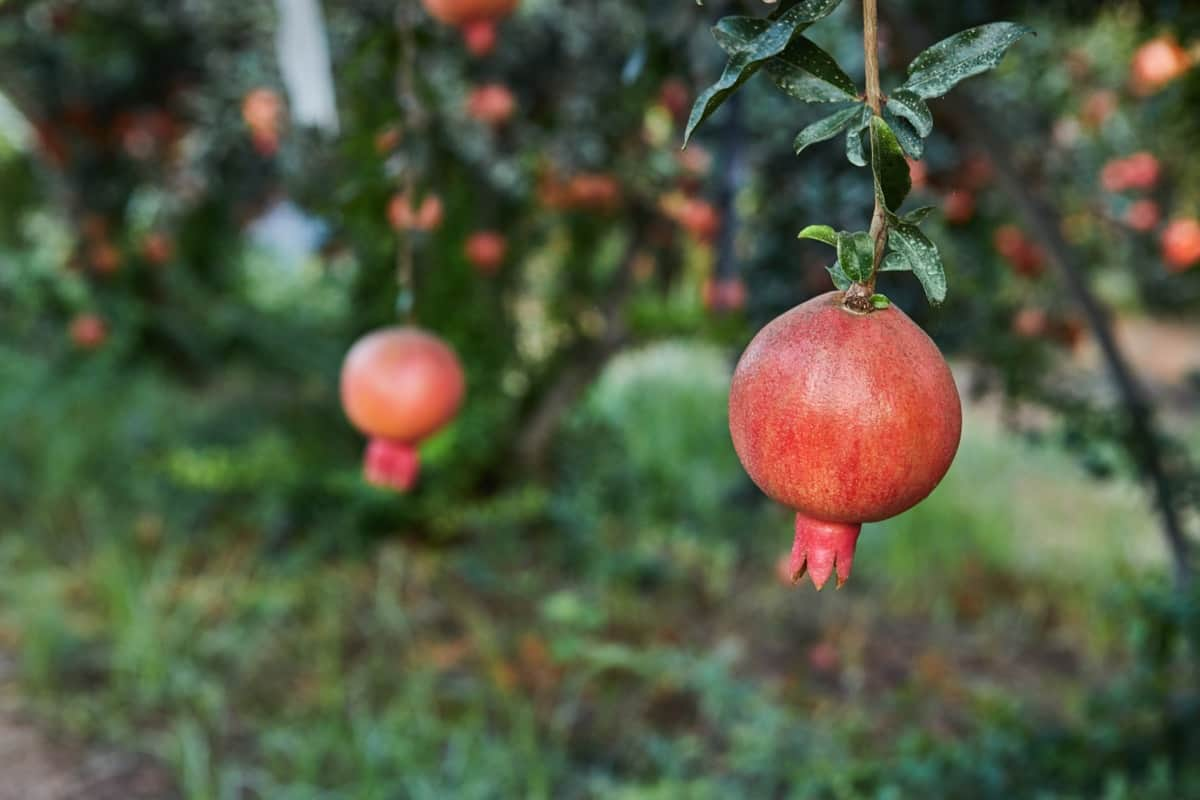
Weed management: Implement effective weed control measures to minimize competition for nutrients, water, and light. Utilize mulching, inter-row cultivation, and manual weeding to manage weed growth. Employ weed management practices specific to each crop’s tolerance and growth stage.
Harvesting and post-harvest management: Plan and execute timely harvesting practices for each crop in the intercropping system. Handle harvested crops carefully to minimize post-harvest losses. Employ appropriate storage and processing techniques to maintain crop quality and extend shelf life.
Data shows that adopting proper crop management techniques for successful intercropping can lead to significant benefits. Studies have demonstrated increased crop yield, resource-use efficiency, and economic returns compared to monoculture systems. For example, research on intercropping systems like maize-bean and maize-pigeon pea reported yield advantages ranging from 10% to 30% compared to sole cropping. Similarly, intercropping systems like soybean-maize and sorghum legumes have shown improved nutrient-use efficiency and reduced pest pressure.
Conclusion
Intercropping techniques in pomegranate orchards offer a promising opportunity to maximize farmers’ income. Farmers can double their earnings from pomegranate cultivation by effectively implementing intercropping strategies, leading to increased profitability and sustainable agricultural practices.
- Types of Pesticides Used in Agriculture: A Beginner’s Guide
- Economical Aquaculture: A Guide to Low-Budget Fish Farming
- 15 Common Planting Errors That Can Doom Your Fruit Trees
- How to Make Houseplants Bushy: Effective Tips and Ideas
- Innovative Strategies for Boosting Coconut Pollination and Yield
- Pollination Strategies for Maximum Pumpkin Yield
- The Complete Guide to Chicken Fattening: Strategies for Maximum Growth
- Natural Solutions for Tulip Problems: 100% Effective Remedies for Leaf and Bulb-Related Issues
- Revolutionizing Citrus Preservation: Towards a Healthier, Greener Future
- Natural Solutions for Peony Leaf and Flower Problems: 100% Effective Remedies
- Maximizing Profits with Avocado Contract Farming in India: A Comprehensive Guide
- Natural Solutions for Hydrangea Problems: 100% Effective Remedies for Leaf and Flowers
- The Ultimate Guide to Choosing the Perfect Foliage Friend: Bringing Life Indoors
- From Sunlight to Sustainability: 15 Ways to Use Solar Technology in Agriculture
- The Ultimate Guide to Dong Tao Chicken: Exploring from History to Raising
- The Eco-Friendly Makeover: How to Convert Your Unused Swimming Pool into a Fish Pond
- Mastering the Art of Delaware Chicken Farming: Essentials for Healthy Backyard Flocks
- 20 Best Homemade Fertilizers for Money Plant: DIY Recipes and Application Methods
- How to Craft a Comprehensive Free-Range Chicken Farming Business Plan
- Brighten Your Flock: Raising Easter Egger Chickens for Beauty and Bounty
- How to Optimize Your Poultry Egg Farm Business Plan with These Strategies
- Subsidy for Spirulina Cultivation: How Indian Government Schemes Encouraging Spirulina Farmers
- Ultimate Guide to Raising Dominique Chickens: Breeding, Feeding, Egg-Production, and Care
- Mastering the Art of Raising Jersey Giant Chickens: Care, Feeding, and More
- Ultimate Guide to Raising Legbar Chickens: Breeding, Farming Practices, Diet, Egg-Production
- How to Raise Welsummer Chickens: A Comprehensive Guide for Beginners
- How to Protect Indoor Plants in Winter: A Comprehensive Guide
- Ultimate Guide to Grow Bag Gardening: Tips, Tricks, and Planting Ideas for Urban Gardeners
- Guide to Lotus Cultivation: How to Propagate, Plant, Grow, Care, Cost, and Profit
- Agriculture Drone Subsidy Scheme: Government Kisan Subsidy, License, and How to Apply Online
- Ultimate Guide to Raising Araucana Chickens: Breed Profile, Farming Economics, Diet, and Care
- Bringing Hydroponics to Classroom: Importance, Benefits of Learning for School Students
- Ultimate Guide to Raising Polish Chickens: Breed Profile, Farming Economics, Diet, and Care
- Ultimate Guide to Raising Australorp Chickens: Profile, Farming Economics, Egg Production, Diet, and Care
- Silkie Chicken Farming: Raising Practices, Varieties, Egg Production, Diet, and Care
- Sussex Chicken Farming: Raising Practices, Varieties, Egg Production, Diet and Care
Wooow, very informative and quite encouraging to go the intercropping route. As a first time aspiring pomegranate farmer, I am ready to start on the right footing by adopting the intercropping way.